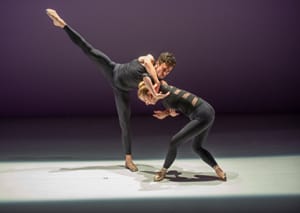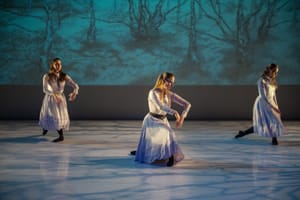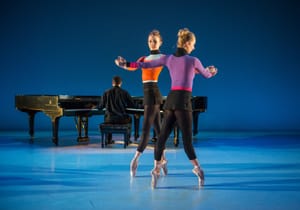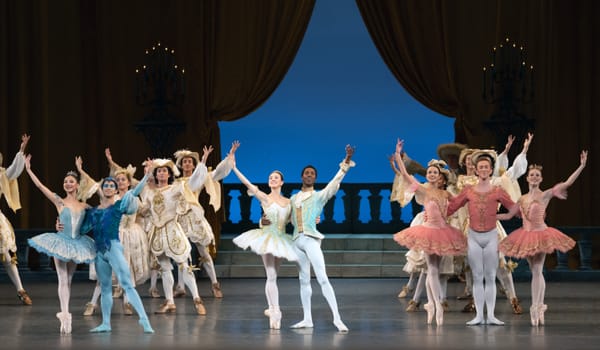Enigmatic Explorations

“Different Homes,” “Picnic,” “Surmisable Units”
BalletNext
New York Live Arts
New York
January 16, 2014
Both daring and self-contained, BalletNext’s presentation of An Evening by Brian Reeder was an intriguing visual delight that left just enough unsaid. The program featured three works choreographed by Reeder: the New York premiere of “Different Homes,” the world premiere of “Surmisable Units,” and an older work, “Picnic,” from 2012. All three were performed to live music and offered a creative depth that came from a keen exploitation of minimalism, proving that less can indeed be more.
Presenting original, creative works was the goal of this company when Michele Wiles co-founded it with Charles Askegard in 2011. Askegard has since departed to become associate artistic director of Minnesota Dance Theatre, but with Wiles remaining at the helm of BalletNext, it appears to have established a steady footing, and the evening’s program is reassuring of the company’s commitment to its objective.
Almost as a testament to the confidence in its direction, the company opened the show with its least embellished and most thought-provoking work, “Different Homes.” The piece is a fascinating duet set to Benjamin Britten’s Cello Suite No. 1 for the duration of which the dancers’ hands never touch. Dressed in all black, Wiles and Jens Weber first appeared standing several feet apart on the darkened stage in a rectangle of light, but soon their bodies spurred into motion, snaking and entwining, all with a maintained distance dictated by the lack of the most common form of human contact. The stage was flooded with different colored light as the work progressed, adding dimension to the chemistry of a couple that was endlessly linked, but never truly connected.
The work’s minimalist presentation and solo cello accompaniment allowed for a quiet and undistracted focus on what was conveyed, and what was trapped in the expressive silence of the two dancers’ movements. In the absence of the hands’ touch, the viewer was invited to explore the emotions that could exist in a human closeness that is not absolute. The restriction on touch also had an aesthetic advantage. Because this seemingly minute limitation makes many partnering staples unavailable, it liberated the hands and wrists and allowed Reeder to assign to them movements that one may not otherwise see in a performance.
Most importantly, what sets “Different Homes” apart from other similar works is its ability to keep the viewer wondering about its unspoken meanings, both during duets and individual dances. Paradoxically, during each dancer's solo it is the other dancer on the periphery that appears most interesting. What thoughts and feelings inhabit them while their partner is center stage? At one point, as Weber performed his high-charged, expressive variation of intricate steps, Wiles walked alongside the back of the stage and then down stage left, first following him with her eyes, but then moving independently, only to be reunited again for a duet. Each viewer would see it differently, and when the last note was played and the lights faded to black, endless interpretations of the work lingered.
The second piece in the program, “Picnic,” was inspired by the 1975 film “Picnic at Hanging Rock” - a story about the disappearance of several schoolgirls and their teacher from a picnic trip - and was the only work for which the printed program provided any guidance. The viewer was prepared with a single quote from Edgar Allen Poe: “What we see and what we seem are but a dream, a dream within a dream,” a line that is also uttered in the film. But familiarity with the motion picture is not needed to enjoy the mysteries embedded in this work.

“Picnic” began and ended with Wiles sitting alone on a picnic blanket in near-darkness. Shortly after the first few notes of Dmitri Shostakovich’s Cello Sonata in D Minor were played we met four other girls and a man. Each of the women in this work seemed quietly occupied by troubling thoughts. There was also something shared between them that went unsaid, a placid apprehension or a secret. Unlike “Different Homes,” this work offered more cues for the imagination and was richer in content.
Could the kiss passed down between three girls from cheek, to forehead, to lips signal a coming of age? Were two of the girls following this mysterious man as he moved offstage or were they just behind him by coincidence to proceed dancing downstage? Is the commonality between these women in Victorian dresses actually nothing more than the bindings of social conformity? Periodically these women would lie down, as if asleep, calling into question whether the active moments were real at all.
The male role, danced by Weber, was equally mysterious. Is he a friend, a foe or a love interest? Towards the end of the piece Wiles danced with him which suggested a romantic link, but that did not last, and as he left the stage for the last time he examined the four women and took two of them with him. Wiles returned to her place at the picnic blanket, looking knowingly into the distance.
BalletNext is a purposely small company composed mainly of dancers with respectable tenures at large troupes in their pasts, and of all the works in the program, “Picnic” illustrated best how the company's repertory benefits from the experience these seasoned artists bring to its performance. Wiles in particular seemed to approach the interpretation of each work and infuse each movement with the kind of forethought and artistic freedom that she didn’t feel she had the chance to exercise as a principal at American Ballet Theatre. Unfortunately, “Picnic” also underscored the shortcomings of physical execution and conditioning of the company’s dancers, particularly in more classical steps. This seems to be the peril of occasional freelance work and being away from the daily physical rigors and demands imposed by larger companies. It made you wonder what the pieces could look like if the steps were delivered as well as the artistry.

After the deep minimalism of “Different Homes” and the rich mystery of “Picnic” came the surprise that was “Surmisable Units.” Before the work began, two pianos were placed in the middle of the top of the stage angled toward each other. The music for this piece, Steve Reich’s “Piano Phase,” functioned as both accompaniment and stage design and was performed nonstop for over fifteen minutes by just one pianist – Ben Laude, with his right hand playing on the right piano, and left hand playing the same notes on the other. The two identical melodies slowly went out of phase with each other, and just as the audience adjusted to this strange but remarkable accompaniment, on walked the dancers, one by one passing along the back, pausing in between the pianos, their faces covered by silver, featureless masks.
Unlike the other two works, “Surmisable Units” is strictly visual. The choreography is folded into the music and the set to become one with the different elements. It ranged from the more classical-looking duet performed by Brittany Cioce and Stephen Hanna, to the more modern and liberated interplay between Wiles and Kaitlyn Gilliland. The music is simple, and in isolation at times monotone, but that allowed the dancers, now with the masks off, to become one with it. They provided contrast to the sound, here experienced with the eyes, adding cadence perceivable through a different sense.
At the end of the piece Weber completed an intricate solo, walked over to the pianist and joined him sitting down on the stool. He looked into the audience for a moment and finally let out a tired exhalation, leaving us wanting more.
copyright © 2014 by Marianne Adams



